#Hanfu from china
Text
[Hanfu · 漢服]Chinese Warring States period(475–221 BC) Chu (state) Hanfu Based On Chu (state) lacquer figure
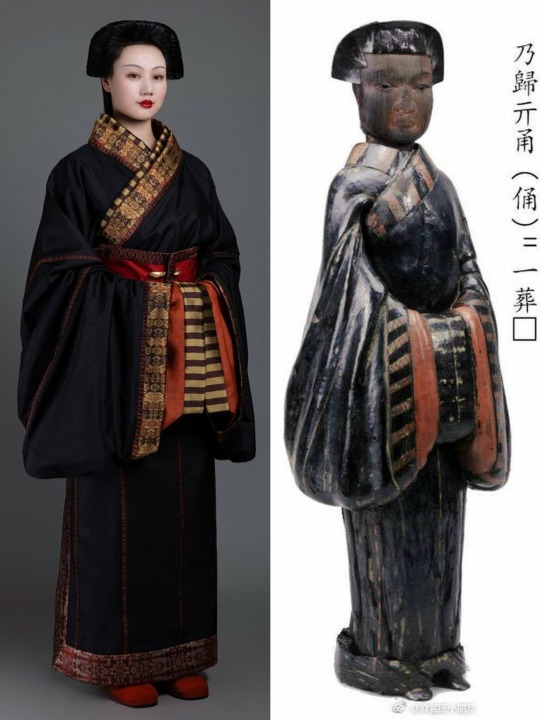

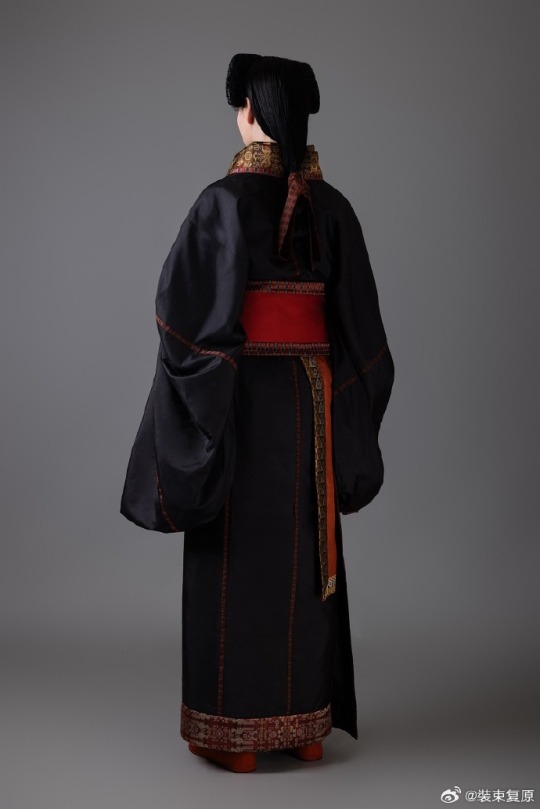
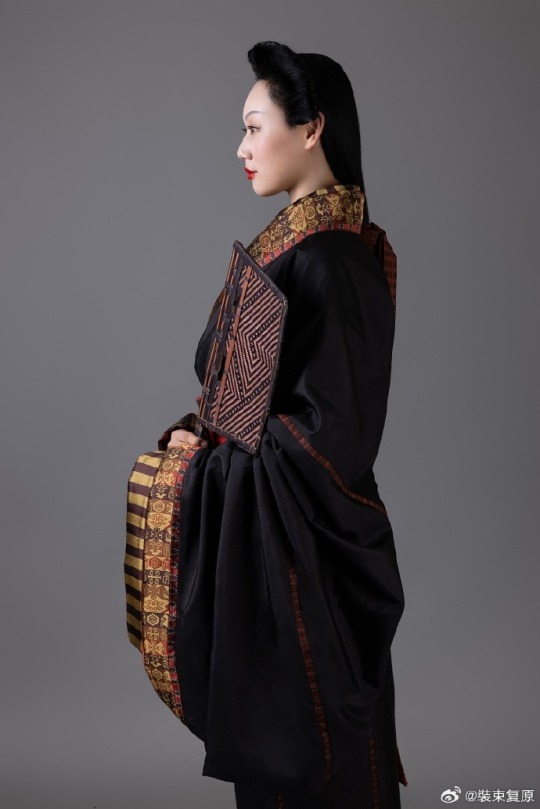
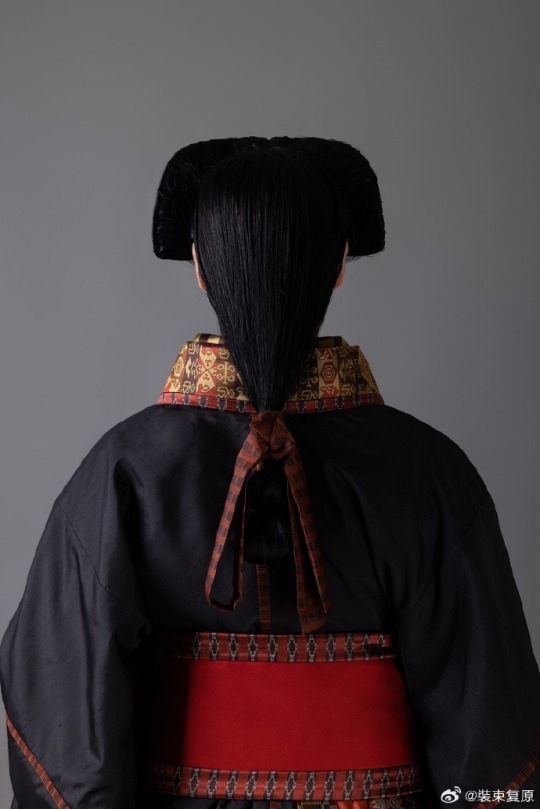
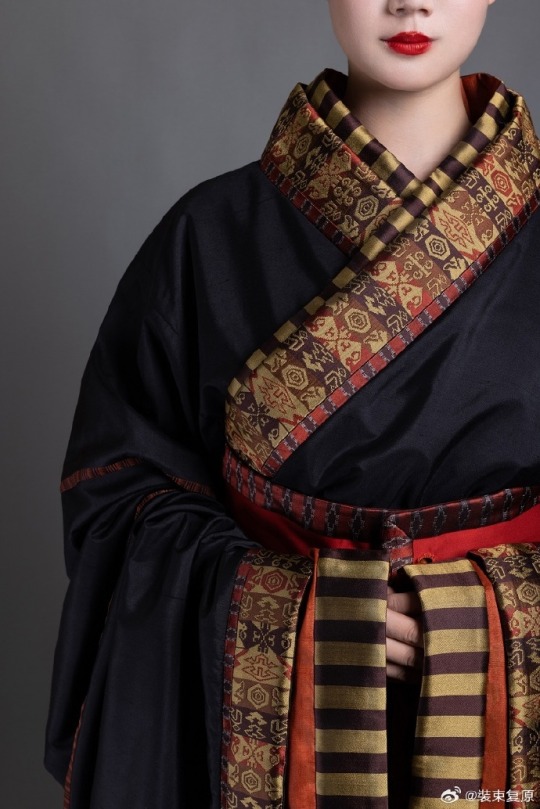
【Historical Artifact Reference】:
Lacquered wood figurines unearthed from Chu State Tomb in Shayang Tumbun Chu Tombs/沙洋塌冢楚墓出土漆俑

Collar cloth and robe unearthed from china Mashan Chu Tomb N19
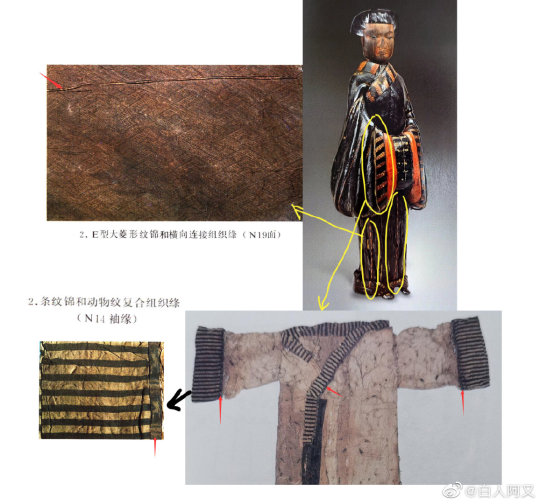
【Histoty Note】Warring States Period·Chu (state) Noble Women Fashion
Many people may wonder why this set of clothing and hairstyles are so similar to Japan, but the fact is this kind of clothing and hairstyle existed in China at least 1,000 years earlier than Japan.
During the China Warring States Period, it was popular for aristocratic men and women to wear robes.
Lacquered wood figurines and robe with similar images have been unearthed from the Shayang Tumbun Chu Tombs and the Chu Tombs at Mashan, many of which adopted the "three-dimensional structure" technique.
For example, a roughly rectangular piece is caulked at the intersection of the robe's sides, skirt sides and sleeve armpits. At the same time, the lower edge line of the top and the upper edge line of the lower skirt are incrementally extended, and then sewn into one body. It is called "Ming three-dimensional structure".
Its ingenuity is that while the outer contour of the garment remains unchanged, it effectively expands the inner space of the garment body, making it convenient for people to wrap the garment from the front to the back when wearing it, without damaging the original collar and garment forms.
The attire of aristocratic women from the Chu state in this set was restored based on the lacquered wooden figurines of the Chu tomb in Shayang. Their foreheads and temples hair are fluffy, and they have a hanging bun at the back of their heads. They wear robes that are connected up and down, and are decorated with brocade inlays at the seams.
The wearing method is the "layering method", two robes are stacked together in advance and then worn as a whole. This allows the collar edge of the lining to be show parallel to the collar edge of the outer garment, and a section of the lining to be show behind the lapel.The brocade edge is decorated with a wide belt and fixed with double belt hooks.
This "layered" wearing method shows the layers and details of Chu people's clothing, and can also show the graceful beauty of the body.
In addition, many creative clothing styles and fabric patterns emerged during the Spring and Autumn Period and the Warring States Period, bringing with them the unique atmosphere, mysterious imagination and ultimate romance of that era, becoming our inexhaustible source of art.
--------
Recreation Work by : @裝束复原
Weibo 🔗:https://weibo.com/1656910125/NhBx1oi5n
--------
#chinese hanfu#Warring States period(475–221 BC)#Chu(State)1030 BCE – 223 BCE#hanfu#hanfu accessories#hanfu_challenge#chinese traditional clothing#china#chinese#hanfu history#hanfu fashion#imperial china#chinese culture#chinese style#historical fashion#Hanfu From China#漢服#汉服#楚国
634 notes
·
View notes
Photo
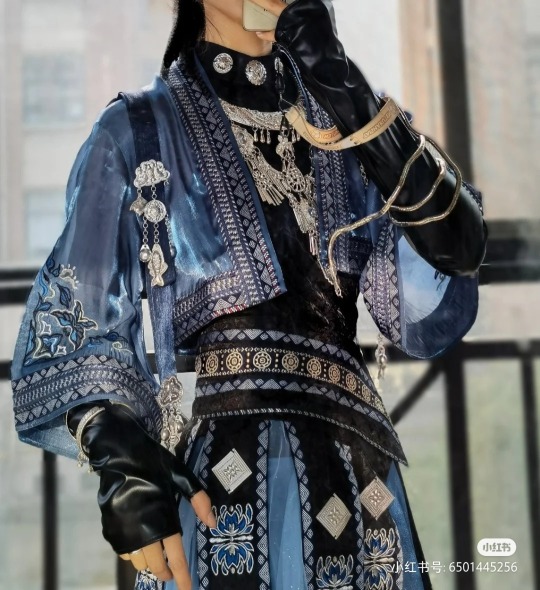
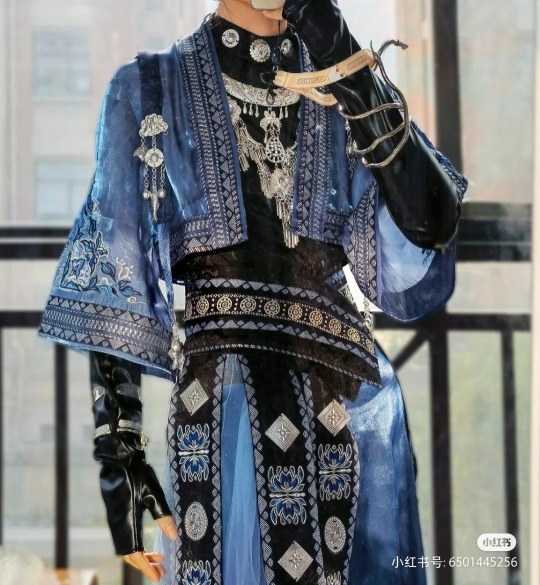
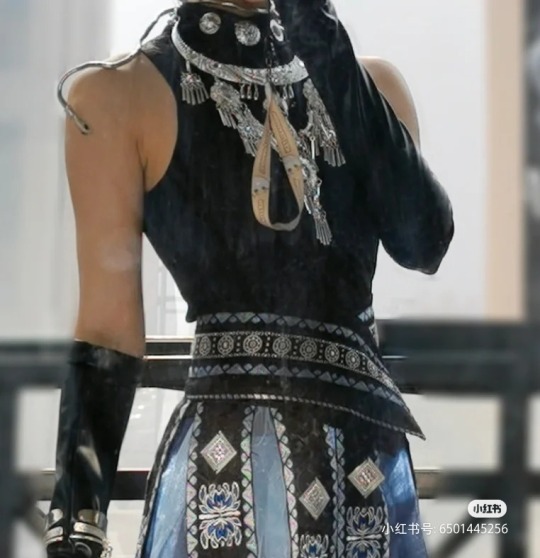


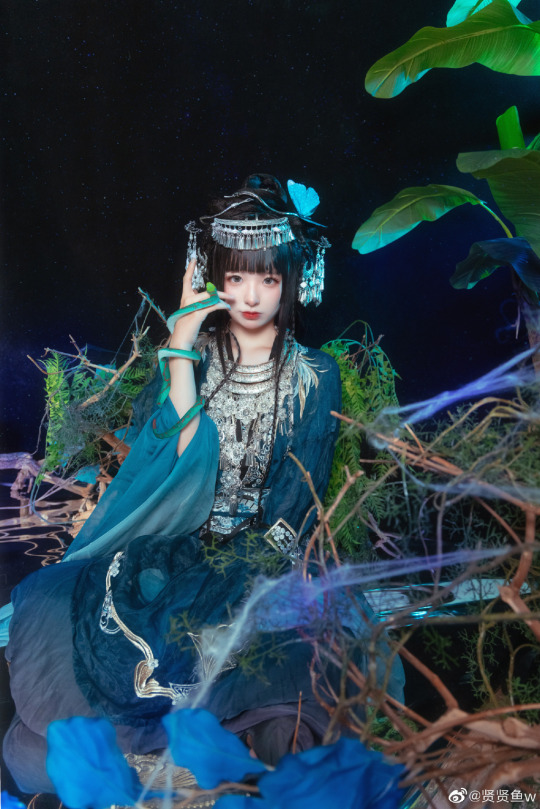
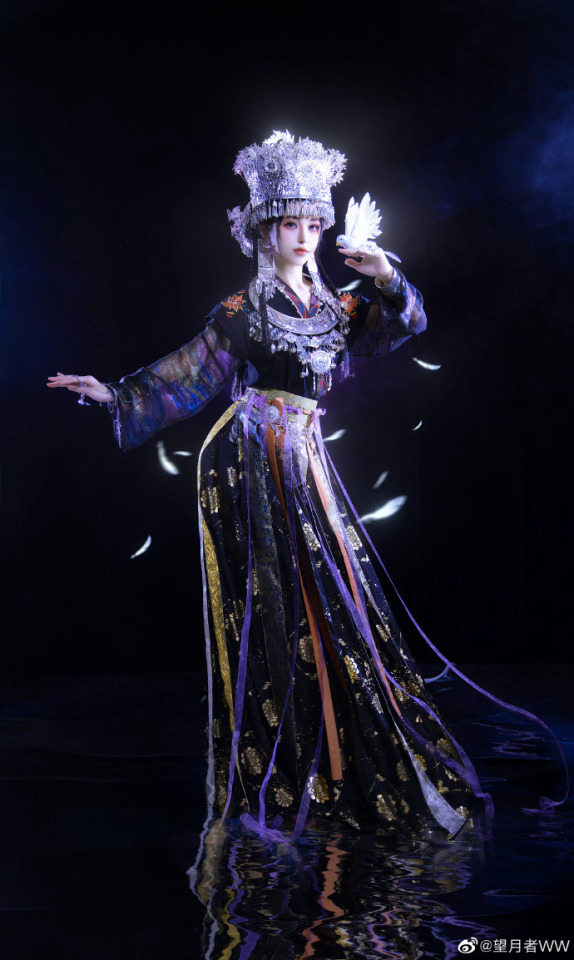
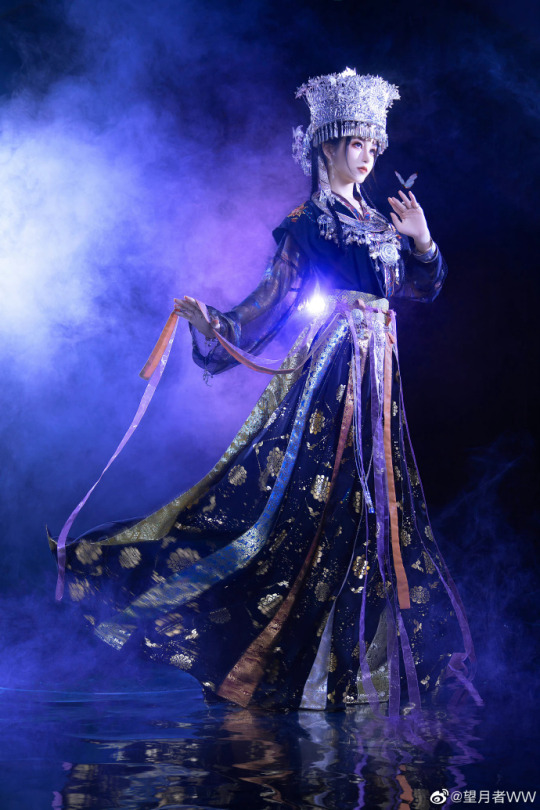
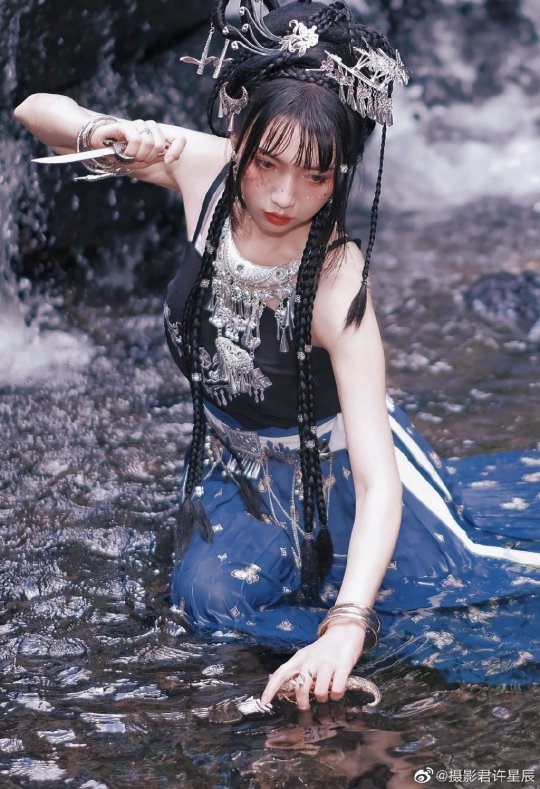
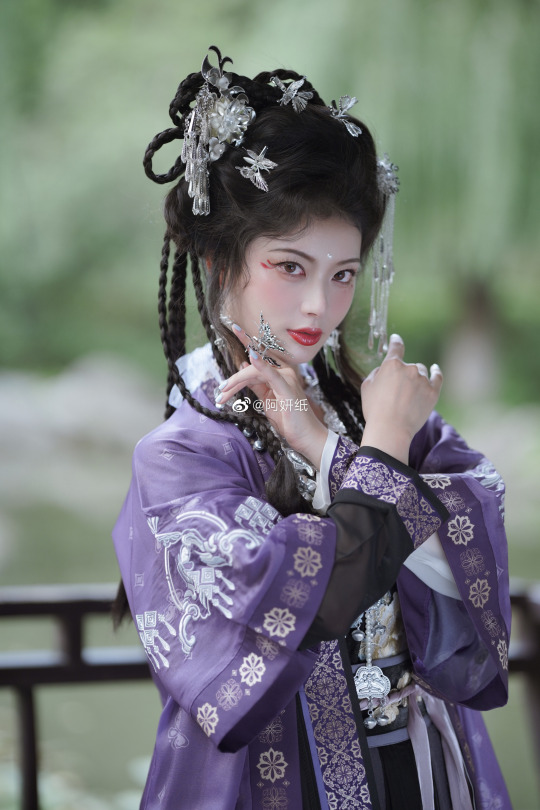
hanfu fashion matched with miao fashion by chinese designers
#china#hanfu#fashion#chinese fashion#miao fashion#designers call this type miaojiang style#miaojiang苗疆 is a concept originated from wuxia culture#wuxia mmorpg game usually have a martial art school called 五仙教 or 五毒教#that is inspired by miao people#miaojiang style is influenced by character design of these mmorpg game#the animals and insects elements such as small snake#butterfly#spider etc. are related from 五毒wudu#it symbolizes the 巫蛊wugu culture of 五毒wudu in wuxia fictions and games#credit as watermark
2K notes
·
View notes
Photo
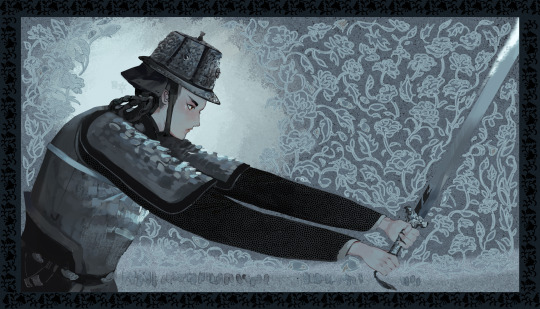
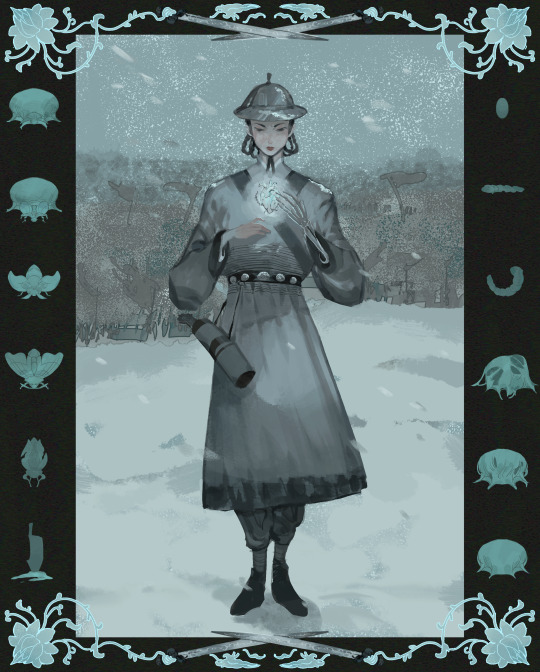
A Heart of Ice and Jade
I finished SWBTS a while ago and I love general ouyang so much! I’ve been waiting to read the book since 2020 but only got my book a few days ago, ahhhh it feels so surreal! well written eunuch antags are so rare in historical fiction and I never thought I’d live to see one beautifully written like a trans mlm, this really satisfies my incredibly specific niche (I’ve been fascinated by the concept for years), sorry I don’t know how to authentically describe how much ouyangs character means to me, he’s genuinely (almost) everything I’ve wanted to see in historical fiction, like oh my goodness... he raised the eunuch antag bar way too high now I’m gonna be disappointed when I read anything else
thank you if you read my entire paragraph above I feel like its really hard to articulate just how much I love ouyang as a gay dude with a eunuch hyperfixation... hope u like the art!
#swbts#she who became the sun#general ouyang#swbts fanart#art#yuan dynasty#hanfu#ancient china#i spent longer drawing these than i spent reading the book#i hope my visualization of him is ok!#there r some minor inaccuracies sorry about that#did u know the room in which eunuchs were castrated was called the canshi aka silkworm room#thinking about how his braids were likened to the wings of a moth once...#i referenced the hand drawn patterns from some yuan artifacts!#he reminds me of zhou yu actually#beautiful talented man who has beef with the mc with magical powers#yix gallery
1K notes
·
View notes
Text
iunno how it works into the plot line but I like to think Corrin met Sumeragi after he married her mom, and prior to that she was Sofia the firsting her way through life
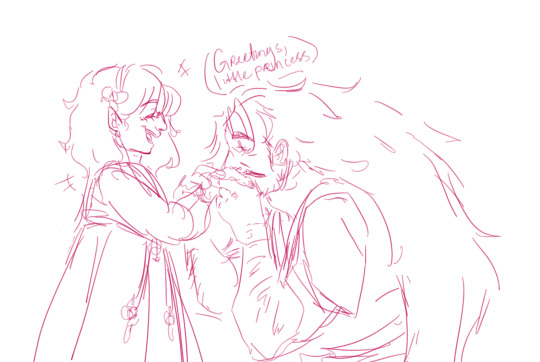
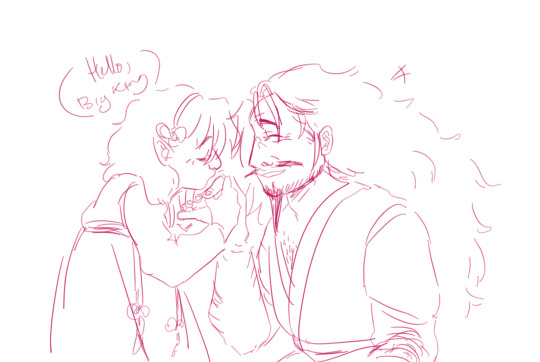
#“why do the characters look different in both images?” good question! i did the first one before I went to sleep and the second one when I#woke up and had the mental capacity for a sketch layer#my art#fe fates#fire emblem fates#corrin#corrin fire emblem#sumeragi fire emblem#also if you wanna ask why corrin's in hanfu its because valla is based off china? from what I learned
29 notes
·
View notes
Note
regional hanfu styles?
i've always wondered if hanfu ever varied from region to region? what i've seen so far on hanfu makes it look like everyone wore the same styles across china but that seems so strange since most of chinese culture is very regional. so are there region specific hanfu styles or is hanfu really that general?
Hi!
It totally did historically. The further away a region from the centre of fashion (e.g. the capital) was, the more behind the fashion the region was. Usually the distinctions could be found in embroidery style, cut, length etc. I read that sometimes it could be a couple decades behind, especially in times of unrest and wars. A more recent example could be seen in Chinese diaspora in the late Qing, e.g. a Vancouver Chinese tend to dress in an older style then like say, Shanghai. Also last year a local hanfu tailor shop was submitted to a weibo tea account because it is too pricey for its old-school out-of-fashion products. (They do occasionally have some more "up-to-date" hanfu.) On the other hand, sometimes the royals would want to keep a look of "plain and simple", like in Ming dynasty, the fashion inside the Imperial Palace was lagging behind. When the clothing length and sleeves sizes increased in the South (Jiangnan area), the clothing inside the palace was kept shorter and fitter.
Modernly, since a lot of hanfu community is online, the distinction isn't as obvious, especially when most people buy hanfu online. There are distinction in materials and layering mostly due to the local climate, e.g. Guangzhou residents (in the south of China) might still be wearing a thin ao, while people in Beijing will have worn layers of wool, fur or dawn. Sometimes local communities of hanfu-ers would have a certain styles (either because there is a popular fashion icon in the group or they tend to bulk purchase from the same shop), but I usually can't tell them apart unless I am familiar with said group.
#ask#fouryearsofshades#hanfu#i can tell if a group picture was from my or my neighbour country#there is a certain vibe#they used to have an annual camp before the covid#and a lot of people get their first hanfu there#and it is pretty much a tell#in one year they still did the old school quju#when people in china had already moved away from that style of a couple of years#so i think the lagging behind part is valid#but only for communities that is mostly made of locals and not like oversea students
70 notes
·
View notes
Text



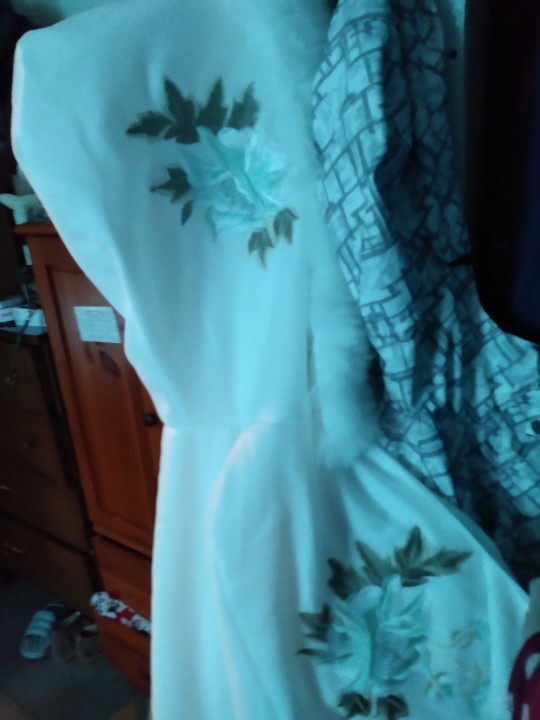
im. shook by how long this is DFGGHFHGGJHGJHHHHJHJHHHGHHHJ
#arcana.uploads#cloak came in !! the doupeng is a winter cape or cloak originating from china !!#WAAAAAAAY warmer than my& actual coat lmao#tbh ive been debating getting hanfu related stuff for a while but i finally said why not especially bc it's an open culture#& as an indigenous person it's showing respect for another culture !!#& not to mention our& sibling sys who's mixed chinese said as long as you're being respectful of the cultureyou're fine !!#& as sb who's learning mandarin & eventually plans on traveling to china at some point w/ our& sibling sys for a trip it's good practice!!#we said if we'd go in winter we'd wear doupeng SDFFGHLLLITDDFGJJGGHKJH btw if ur reading this anderson ilyyyyyy /fam
0 notes
Note
do you have any idea when people in china stopped bowing to each other as a greeting? it seems like the most common forms of greeting now is to shake hands or wave both which were introduced from the west. it's the same in taiwan too.
Tldr: It never stopped because Chinese people never had the practice of bowing in greeting the way that Japanese people did/do.
-
(Note: there are types of greetings that involve a sort of bowing (ketou), but this is reserved for special occasions)
Back in the day, the greetings were made by clasping one's hands in front of them in the direction of the person being greeted. There might be some head lowering/slight bowing involved but it's done in conjunction with the hand greeting. You can see various forms of this in historical dramas and even hanfu shows and shortform videos. The exact way one held their hands changed in some years but the general idea is the same.
Women's and men's hand greetings differed back in the day. A women's greeting was called 万福礼 wànfùlǐ and consisted of holding the hands in front of oneself and bending the legs, or holding hands at the hip, etc. The exact way to hold the hands also changes through the years. Women also do what is called 肃拜 sù bài, which is an earlier form of a women's greeting and includes getting on one's knees (thus the 拜).
Some examples of greetings:
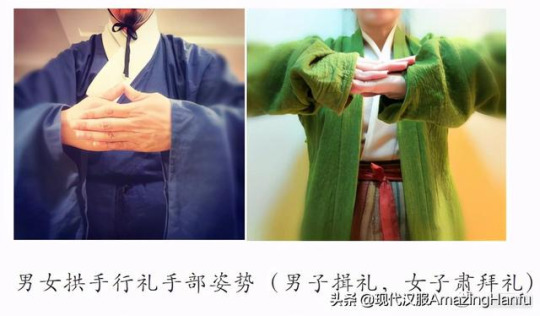
Men's vs women's hand positions


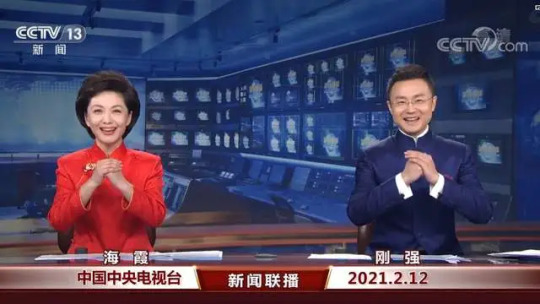
拱手礼 gōngshǒu lǐ ("cupped hands greeting"). The most common greeting. Top photo shows the gendered difference for proper etiquette for nowadays if you ware going to do it, for example, as a new year's greeting.
Bottom photos: I think if you look carefully in modern society, you can still see examples of this greeting in China. It is a gesture that can also be used to expresses one's gratitude. It is still there, it's just fell out of vogue in favor for waving and hand shaking.
This can also be seen in The video above shows Ming era 万福礼 as well as men's 揖礼. 作揖礼 zuòyī lǐ ("bow with clasped hand greeting") is kind of the same thing as 拱手礼, but 作揖 specifically includes a slight bow whereas 拱手礼 is merely the raising of the hands.
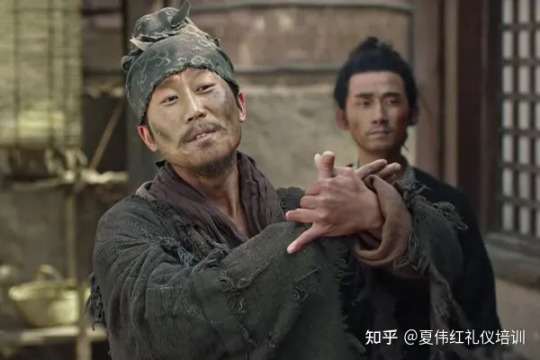
叉手礼 chāshǒu lǐ ("crossed hands greeting") popularised during the Western Jin - Song dynasties, seen in the drama "The Longest Day in Chang'an", which takes place in the Tang Dynasty. This particular greeting started out as one used by Buddhists in the Eastern Han dynasty.
https://zhuanlan.zhihu.com/p/489897518

抱拳礼 bàoquán lǐ ("cupped fist greeting"). This one is something done more so by martial artists. For men, you use your left hand to cover your right hand. For women, the opposite is true. It is also called 吉拜 jíbài when showing respect. If you flip your hand (keep in mind men/women do this the opposite way), it is called 凶拜 xiōngbài and it used to show respect to the dead. So one has to pay attention to this.
There's kind of a lot more etiquette rules you could get into but this answer has already sort of gone beyond the scope of your question lol. Chinese people wrote rites books over the many dynasties so actually there are descriptions of how these greetings were done and over time and that's how they are replicated in dramas and movies.
1K notes
·
View notes
Text
Some historical clothing enthusiasts who AREN'T White because I'm sick of seeing White girls in 19th century clothes:
SewRena: specializes in 1950s American sewing & clothing, she is Black
Cosplay Queen: Chinese youtuber who does stuff like makeup, Hanfu of various time periods, Chinese classical dance, & cosplay. Also does a lot of Mukbang vids
MochiHanfu: another Chinese youtuber who specializes in Hanfu
NamiSparrow: Indian cosplayer who has some vids up about historic Indian fashion & sewing
Notyourmommashistory: Black reenactor who does vids on 1800s fashion, slavery in the 1800s, racism, vintage clothing, & also some cool video essays.
Cheon-Shik Yang: he is a Korean tailor who talks about Hanbok & traditional Korean clothing
Fashion & Culture with Kingsley: focuses a bit more on contemporary African clothing & fashions & geared towards fashion designers, but inspired by traditional African designs (from different countries and cultures, such as Ghana, Ethiopia, & Senegal) and clothing & a bit of historic ones as well.
The Couture Courtesan: mixed race Asian reenactor and historical fashion enthusiast who talks about fashions of various time periods, as early as the Tudor era up to the 1910s.
Eccentrik: Jamaican youtuber with vids focusing on fashion, & in particular either vintage fashion (I believe 1940s-60s), pinup fashion & hair & makeup, or vintage inspired sewing
Ora Lin: a nonbinary tailor (who I believe is Asian), they make videos about sewing & historical fashion of different periods & places, including Regency England, Jin & Ming dynasty China, the Edwardian era, & more.
Honorable mention: Snappydragon not a person of color, but she is Jewish & focuses on European historical fashion & Jewish historical fashion (including time periods the Jewish population would not be considered "White")
6K notes
·
View notes
Text
sometimes i think about keeper of the lost cities (it is my special interest) and go “holy shit how is this a middle grade series”
so here is an incomplete list of things that happen in kotlc that would get a kotlc movie’s rating moved to R (read at your own risk).
kidnapping
torture
horse copulation
graphic violence
graphic birth
unspecified but apparently flavorful cursing
human experimentation
body horror
very detailed depictions of almost-deadly allergic reactions
non-consensual drugging. a lot of it. of CHILDREN
and here is a list of things that i think the US government would hate about kotlc
criticism of government and discussion of how one should handle being in a position of power (you should not enjoy being powerful)
elfin society has a eugenics problem and this is consistently criticized
queer coding isn’t even coding atp marella is GAY gay
and finally, criticisms i have of kotlc.
weird eurocentric beauty standards
tam and linh. great characters. CONSTANTLY fetishized bc they’re asian. sophie calls them k-pop idols, anime characters, etc. from what i can tell, though, they’re vietnamese. LET THEM BE VIETNAMESE WITHOUT COMPARING THEM TO EVERY EAST ASIAN STEREOTYPE
everyone is thin. LITERALLY EVERYONE. why is everyone thin and why does thin equal beautiful. shannon messenger explain your biases challenge
there are SO many poc in the books, but elf culture is shown as a monolith. show the cultural nuances that come from before humans and elves separated. i want to see the human influences in their clothing, hairstyles, accents, vernacular. have elves who have historically lived in china wearing something similar to hanfu. give tam and linh ao dai. give me a nigerian elf with fulani braids. give me culture through style and bodies and voices and music. i want to see it. it’s beautiful and it is NOT shown enough
dex needs more page time.
alden and della are NOT criticized enough. they are complicit. they are part of the problem in the lost cities. they are not all bad, but they are not all good either. CRITICIZE THEM, SHANNON.
126 notes
·
View notes
Text
Some ideas for Twisted Wonderland events
(*Mild spoilers for some JP server events and Chapter 6)
-A Mulan-themed event: In one of the Halloween events, Silver mentioned knowing the story of Mulan, and Lilia has mentioned having been to "the East" before (not to mention Diasomnia's Halloween costumes are longs). It would be lovely to see Lilia return to the TWST-equivalent of China with some of his friends and meeting new characters--bonus points if someone is twisted from Mushu. A story about a girl who makes a sacrifice for her aging father by enlisting in the military on his behalf fits well with Silver and Lilia, so now would be the perfect opportunity to give them duo magic! Also, Chinese xianxia/martial arts fantasy novels are very popular in Japan and abroad nowadays (if you know, you know :) ), and I would love to see the boys wearing hanfu--they'd look so majestic and cool!
-Sam's hometown event: A Princess and the Frog event where the boys go to the TWST version of New Orleans, chaperoned by Sam. It would be a great opportunity to explore the jazz and culinary scene, and, of course, wear 1920s-inspired clothing. Someone in Octavinelle gets an SSR.
-A pajama-party event: Night Raven College hosts an all-night pillow fight tournament, and everyone gets extremely competitive, kind of like Beanfest. Everyone wears pajamas--I'm not sure if they'd have their own outfits, or if the dorms would match and have PJ sets with their logo on it (kind of like the pajamas they sell at the JP Disney Store). In battle, the chibis throw pillows at each other.
-Octavinelle hometown event: We are introduced to the Tweels' parents and/or Azul's mother. Given how Jamil and Kalim's hometown event carried out, it is likely that only one of the three will actually get an event card, but we'll see. In the Halloween event, Riddle mentioned that he's never seen the sea before. Even though he's had a chance in the Lost in the Book with Stitch event (and the developers probably want to give the spotlight to different characters), I'm afraid he doesn't remember it. Anyway, he deserves to go again. Alternatively, there's an event where the boys go to the Sunshine Lands and meet Prince Rielle. In this case, Riddle and Azul must go together--it would be nice to see after the events of Chapter 6.
-Riddle and Trey hometown event/Black Butler crossover: We've already had a Heartslabyul-themed hometown event with Deuce, but this time, we get to meet Trey's family and Riddle's mother. The likelihood that we get a canon Black Butler crossover as well is very close to zero, but it would be really fun to make a few jokes/hints about Riddle having a younger cousin who wears an eyepatch and solves mysteries with his enigmatic butler. Bonus points if Riddle and Jade have duo magic and dress up in Victorian/ouji clothing.
-J-fashion event: Speaking of ouji clothing, it would be amazing if there was an event inspired by Japanese fashions and subcultures. I think there was a part in one of the anthology mangas where Vil gave the Pop Music Club a visual kei makeover. I know the Pop Music Club has their own SSRs already, but I wouldn't mind seeing more outfits in this style.
-An orchestra-themed event: Some of the NRC students form a classical orchestra. Malleus is there, of course--I imagine him playing the cello this time. The Octavinelle trio is there as well with their respective instruments, as is Idia and Riddle both playing violins. I can see Jamil playing a woodwind instrument--maybe a flute, a clarinet, or an oboe?
#disney twisted wonderland#twisted wonderland#twst#riddle rosehearts#trey clover#azul ashengrotto#jade leech#jamil viper#malleus draconia#lilia vanrouge#silver vanrouge#twst silver#twst sam
149 notes
·
View notes
Photo


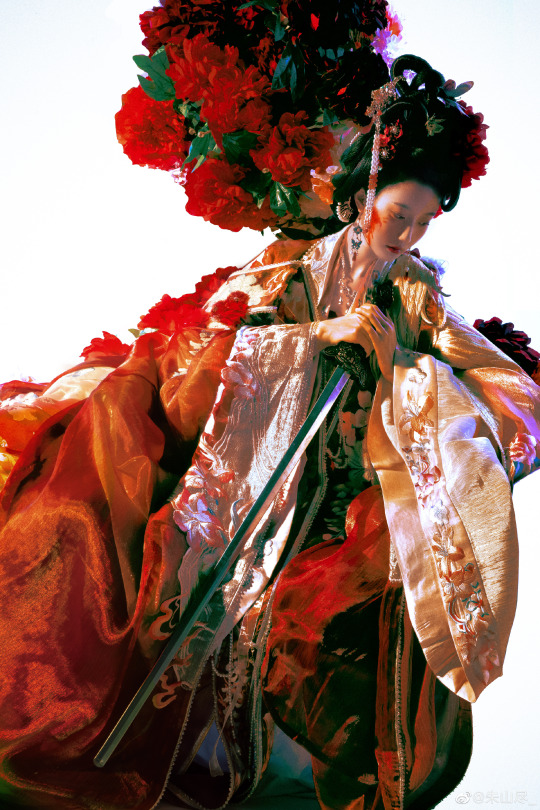
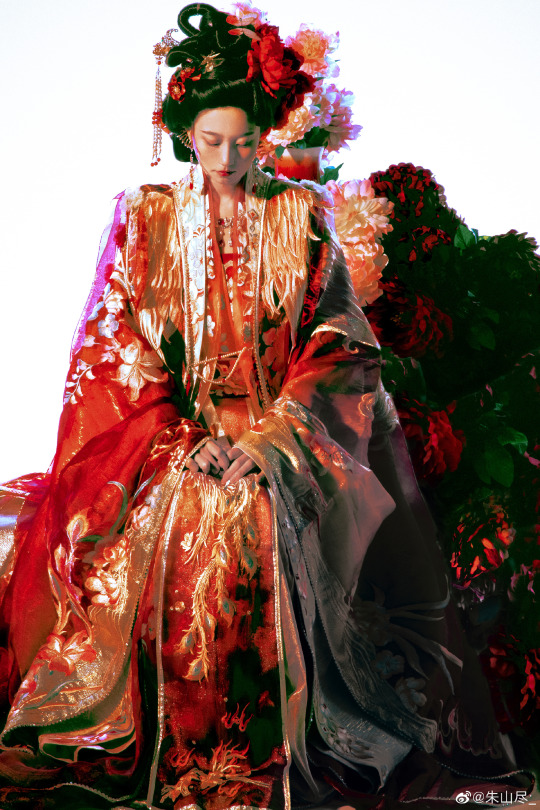
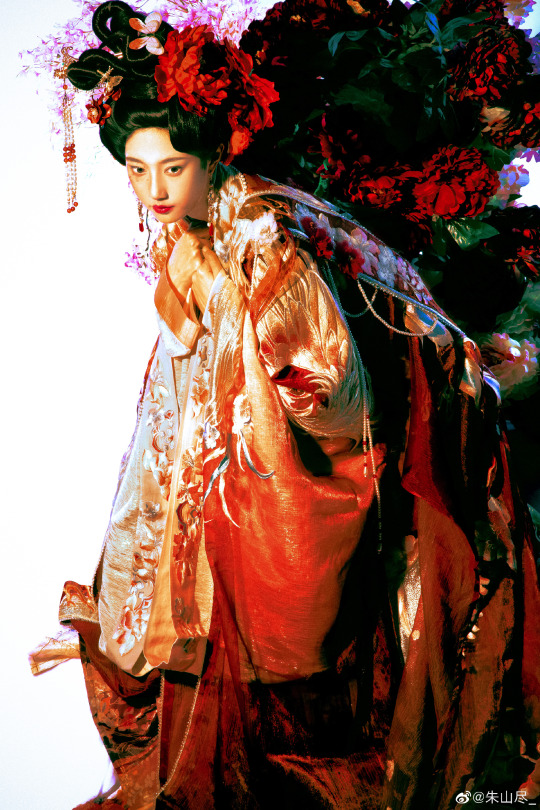
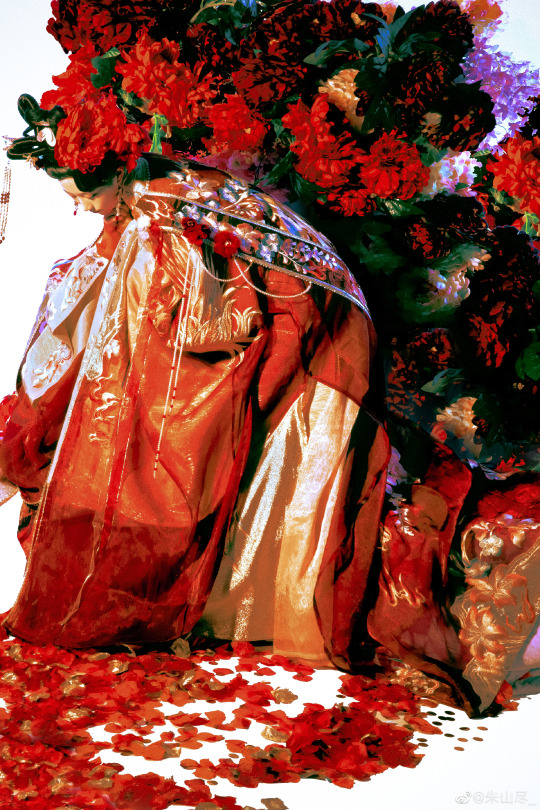
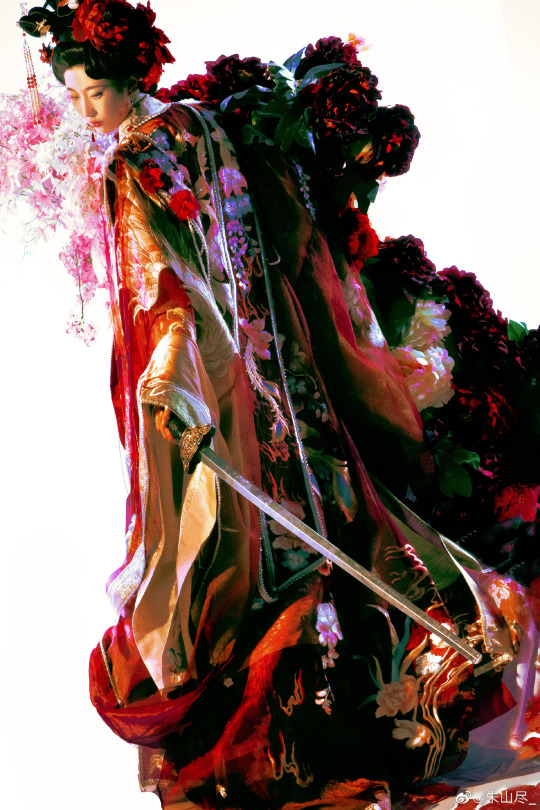
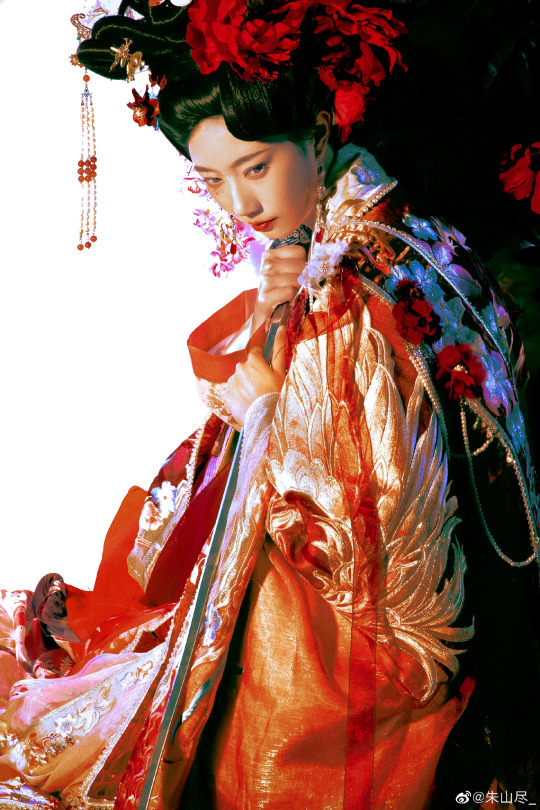
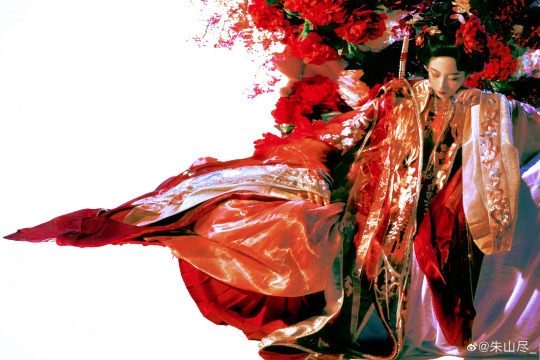
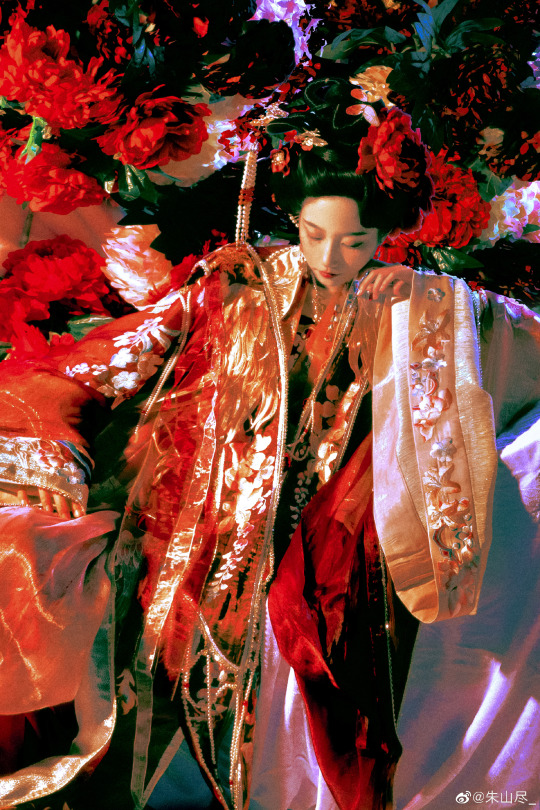
[Hanfu · 漢服]China Song Dynasty Chinese Hanfu Photoshoots-【执欲】
————————
📸Photo:@朱山尽_
👗Hanfu: @异志阁原创国风
🧚🏻♀️Model: 老干部(XiaoHongShu App)
🔗Weibo:https://weibo.com/6906018733/MgyMdBauw
————————
#Chinese Hanfu#Song Dynasty#hanfu_challenge#hanfu#hanfu photoshoot#hanfu art#hanfu accessories#Chinese Costume#Chinese Aesthetics#Chinese Style#hanfu fashion#chinese traditional clothing#Hanfu From China#朱山尽_#异志阁原创国风#老干部(XiaoHongShu App)#漢服#汉服#执欲
1K notes
·
View notes
Text
—𝐓𝐢𝐦𝐞 𝐒𝐭𝐨𝐩𝐬 𝐖𝐡𝐞𝐧 𝐘𝐨𝐮'𝐫𝐞 𝐈𝐧 𝐋𝐨𝐯𝐞

✦ pairing - zhongli x reader
✦ warning - smut, 18+ content, minors do not interact
✦ w/c: 2.7k
✦ disclaimer: afab!reader with no set pronouns, bookstore au, soulmate au [people get a location and date of where they'll meet their soulmates on their watches], fingering, blood, office sex, slight size kink, belly bulge, praising , strangers to lovers, creampie, reader is implied to be in china, unedited


Your hands pushed open the door, allowing a small bell to chime throughout the small bookstore. The smell of ink and old pages wafted throughout the area as shelves stood tall displaying an arrangement of books. Some were leather-bound, others decorative and ornate, and lastly the modern ones that everyone seemed to have in their personal library. You adjusted your back, dazzled by the atmosphere around you.
The dark wood beneath you creaked—sauntering into the establishment—an unconscious smile displayed on your face. You entered one of the rows, grabbing a random book that caught your eye. You gently titled the spine downwards, holding it in your grasp. As you opened the cover, a traditional drawing greeted you—a Chinese woman adorned in a pure red hanfu. Each stroke was precise, as the artist wished it to be. You wondered if the drawing was based on one of the characters in the story or based on the artist’s life. Antique books were always so interesting to you no matter where the region was.
You flipped the page, a hand immediately tensing up as you felt a sudden pain on your fingertips. Your grip on the book slipped as it fell onto the ground, a loud echo rumbled signaling your clumsiness. You furrowed your eyebrows, upset at your clumsiness, as you pressed your fingers together to try to stop the beads of red beginning to appear.
“Are you okay?” a rich, deep voice called out to you. You looked up to see a tall ambered-eyed boy gazing at your form. His small lamp illuminated his gradient brown hair, tied up in a low ponytail. The man’s eyes were filled with worry, it appeared not to be for the antique book you had just dropped but for your well-being. The man took off his glasses—placed them down on the desk he was at before quickly glided over to you. You had to blink a few times processing the situation that you had created for yourself, heat rising to your cheeks.
“Y-Yes! I’m sorry for disturbing you! I didn’t mean to drop the book. If I messed it up, I’ll definitely pay for it!” you stammered out. The man chuckled slightly, the golden light of noon illuminating his sun-kissed skin.
“It’s alright. The book wasn’t damaged, after all. You seemed frazzled so I wanted to make sure you weren’t hurt,” the man replied. He leaned down—grabbed the book from the ground—and rose to his original position, offering the book to you. Your cheeks felt as if they were on fire.
As you mistakenly opened up your injured finger, you noticed the man beginning to frown. The smile completely washed away from his face, worry and disappointment settling into its stead.
“Ah, you did get injured after all…” he mumbled. His large palm tenderly wrapped around your wrist, guiding you over to his desk. Reaching out under the space, he received bandages. With careful fingers, the man wrapped your finger with gauze.
“Be sure to sanitize it as soon as possible. I didn’t have anything to use. I apologize for that,” he murmured. A small laugh escaped your lips.
“I didn’t think I would be tended to in a bookstore of all places today,” you joked outwardly. The man looked back up to you, eyes softening from your statement.
“ I don’t like people getting hurt. I always try to take the opportunity to help as many people as I can,” he replied. Your gaze went down, feeling slightly vulnerable to the man’s look towards you. He was beautiful— tall cheekbones, a beautiful smile, dazzling eyes. He looked unreal in a way.
“There need to be more people like you, honestly. What’s your name, by the way, I never caught it,” you asked. The man rubbed the back of his neck sheepishly.
“Zhongli. I’m the shop owner of this establishment,” he answered. The smile on your face manifested itself into a grin, and your eyes began to sparkle. Introducing your name with a quick reply.
“It is really nice to meet you. But, wow! Do you really own all of these? That’s incredible!” you yelled out. Zhongli chuckled at your excited reaction nodding his head. He turned his head, gazing at the accumulation of books he had around.
“Yeah. I always enjoyed reading. As a kid, I’d always use them as a means to escape and dive into the world the author laid out. Honestly, I think that part hasn’t changed,” Zhongli murmured. You looked down, fingers tapping on the wooden desk.
“I can relate to that too…” you admitted. Zhongli hummed momentarily before returning his gaze to you.
“So, what brought you to my store today? Is there anything I can particularly help you with?” he asked. You looked back up at him.
“Yes actually. This was actually the place I am supposed to meet my soulmate. To think they’d share my love of literature…” you chuckled. Zhongli hummed once more, slightly chuckling to himself.
“Your soulmate? A truly exciting moment then. Ironically, it would appear we share this joyous day since I also am supposed to meet my soulmate here soon. I didn’t expect an unknown bookstore to be etched on my watch when I was young only to collect books and buy this place, after retiring from another field” Zhongli responded. Your eyes perked up. You wonder what he did before he was here.
“Life’s funny in many ways. If you don’t mind me asking, what time are you meeting them today?” Zhongli asked. You looked at your watch, the smile on your face etching into confusion. Typically, the watch was always accurate to the dot. It would have been 2:00 in the afternoon, the bright blue skin reflected in the window reminding you of that.
“That’s odd… For some reason, it’s saying 12:00? That can’t be right. I left my home around that time…” you mumbled, narrowing at the watch. You began to poke at it, worried the batteries after all these years had managed to malfunction. You heard Zhongli grunt, his eyes narrowing on his own watch.
“It appears my watch is doing the same thing, how odd?” Zhongli murmured in confusion. You briefly looked at him before focusing your attention on the window once more. As you were deep in your thoughts trying to figure out this phenomenon, your eyes widened.
“What’s wrong?” Zhongli asked, watching you walk closer to the door. You opened the door again, the bell chiming once more. Confused by your behavior, Zhongli swiftly followed you lead to see you standing on the sidewalk. His own eyes widened standing beside you.
The whole world around you seemed to be frozen in action. It’s as if people walking across the busy sidewalks were mannequins—stopped in motion and posing for you. The cars were stopped even though the green lights remained on. Even the birds in the sky were frozen mid-flight.
“What’s happening…” you whispered out, turning your head to Zhongli in disbelief. Zhongli closed his eyes momentarily—the slight panic beginning melting away.
“...It would appear that our meeting may not be a coincidence after all…” Zhongli replied. His gaze delicately, looking into your eyes. You have read of different couples dealing with odd cases when they first met one another. Historically, people thought it was different Gods and spirits blessing their interactions with one another. Even your own parents couldn’t explain the phenomenon accurately to you.
Only one thing could have done this, one culprit capable of it all...
“...Soulmates…You’re my soulmate, Zhongli,” you mumbled, before laughing. A soft chuckle escaped Zhongli as well as he weaved his hand with yours. As you stared out into the frozen world, your lips curved downwards.
“How does the world return to normal though? Since we met, shouldn’t everything be fine now?” you murmured. Zhongli’s hand slightly tighten before his thumb stroked your own hand before sighing.
“Well, legends say that in order to stop a specific phenomenon affecting soulmates, we have to..consummate our union to celebrate our souls finding one another again,” he replied. You darted your head, cheeks getting hot once more.
“A-Ah! I see…W-Well…” you stammered out. Zhongli leaned over, pressing his lips to your forehead as your heart rapidly thumped in your chest.
“We’ll go at your own pace. I know you weren’t expecting this of all things,” he replied. You sighed, leaning your head into his firm just.
“I-It’s overwhelming but…” you whispered, unweaving your hands with this, “I trust you.”

Zhongli guided you toward the back of the bookstore, where his office resided. With a click of the door, locking the two of you inside, your soulmate sauntered over to your timid form. His hand pressed against the plush of your cheek, feeling the warmth as you leaned into it and smiled.
“Every day I dreamed of you…I’m glad to finally have you in my arms,” he whispered, leaning in towards your lips. Your eyes fluttered closed letting his lips press against your own, large palms that were resting on your shoulder beginning to travel throughout your body. His hands briefly rested on your chest, groping it with a slight squeeze as you slightly moaned from the newfound attention. Seizing the opportunity, Zhongli’s tongue slipped into your mouth hands began to wander again.
His hands rested on your hips, fingers playing with the band of your pants as your lips finally separated from one another—trying to catch your breath. Your lips were glossy, a small string of saliva connecting with his lips. He leaned in once again, claiming your lips with his own as he slightly tugged down at the band of your pants.
“You know…I always wonder what we were like in past lives with one another as lovers…” he whispered out, pressing chaste kisses on your cheeks finally slipping his hands down your pants. You whined, feeling his long cold fingers cup at your entrance—fingers trailing down your slit repeatedly, brushing against the nub of your clit.
“Perhaps I was an all-powerful God. Maybe you were too. Maybe we were both poor but we persisted through the hardships for our love of one another,” he murmured. You slightly gyrated your hips, trying to get any bit of friction from Zhongli’s fingers and encourage him to play with your clit more. Your soulmate merely chuckled, pressing his lips at the pulse of your neck.
“Patience there, bǎobèi. You were such a timid mouse before,” he chuckled, hearing you whine his name once more. The pad of his thumb pressed firmly against your clit as you sucked a breath in before massaging the nub as jolts of pleasure shot through you like electricity.
“You know...my reason for book collecting was to see if I could magically see my previous lives with you. Every word, every story made me feel closer as if you were a whisper away from me,” Zhongli confessed, sliding two fingers inside of you. Your body jumped, feeling the digit sink and slightly stretch you out. Slowly thrusting them inside of you, his lips rested on the shell of your ear, nibbling at the cartilage as you leaned into his touch more.
“It surprises me that it’s our first time together, yet it seems I know the exact ways to make you melt in pleasure,” he chuckled to himself, offering a chaste kiss on your nape again. Your hips bucked, feeling his digits curl against your gummy walls—thumb still bullying your clit. Your walls fluttered against his fingers, trying desperately to clamp down and keep them inside of you as he lifted his free hand to reveal your chest and toy with your taut nipple.
“Z-Zhongli, I-I’m close,” you studdered out, feeling his hand stop all movement once you finished your statement. Your eyebrows furrowed looking up at him with a slight pout as he chuckled once more.
“Ah, Ah. I don’t think it’s fair if the first time I make you cum, it’s my fingers of all things,” he murmured. Your lips quivered feelings his fingers slowly pull out of you, thumb moving away from your clit and inside your pants. His hand was coated with your slick. Seeing your eyes watch his with such attention, Zhongli smiled—popping the fingers that were once inside of you into his mouth. A moan echoed from him as his tongue swirled against the slightly sweet essence of your slick before popping them out once more.
Zhongli quickly disrobed, tan dress shirt and mocha slacks falling down onto the floor near his shoes without a care and you quickly followed his lead. Your eyes focused on the various Intricate geometric tattoos adorned on his muscled arms watching as he slowly pulled his briefs down. His cock immediately shot up, smacking against his lower stomach.
To say he was big was an understatement, honestly, you weren’t even sure it would fit inside of you. Prominent veins decorate his base, as it shivered with desperate pleasure to be inside of you. Precum already leaked from his tip, as his hand jumped his length to smear it across the rest of the base.
He walked over, lining his tip against your entrance, nudging it against your needy clit. Eyes rising back to your own, his gaze softened—pressing his hand against your cheek once more.
“I’m so happy I finally found you again,” he whispered, connecting his lips with yours once more and he soon pushed his cock inside of you. The slow burn flourished throughout your body, trying to adjust to the length sliding inside of you. Your nails harpooned against his back, whining in pain before he finally bottomed out—tip firmly pressed against your cervix. You never felt this full before, as your body tried to adjust to him.
Feeling your walls slowly cave in against his cock, Zhongli slightly pulled out before plunging his cock inside of you again—firmly pressing you against the wall. You cried out his name, feeling his length beginning to press against the satisfying spongey spot inside of you as you gripped him tighter.
“F-Fuck! There! Right there!” you cried out. Zhongli grunted loudly, making sure every angle of his thrust was massaging that spot as he hooked your upper thigh up towards his hip to try to plunge even deeper inside of you. His eyes narrowed, watching his cock disappear insde you time and time again, only to see your lower stomach slightly get bigger every time he thrust. Captivated, he pushed against you only to sharply suck a breath in feeling you squeeze him even more.
Hearing you babble his name repeatedly, Zhongli lifted his hand up from your stomach only to instead toy with your clit once more. He first pulled on the sensitive nub, before rubbing rapid circles.
You were beginning to cave so much, it was beginning to get difficult for him to properly thrust inside of you as the walls of his office rattled with every thrust.
“C-Close. C-Close. Close! Zhongli!!” you babbled out. Zhongli quickly pressed his lips against your own once more, eyebrows furrowed as your back arched—drinking up your whines as you finally reached your high. Your body quivered, tightly pressed against his, as you rode out your high.
With a few sloppy thrusts, Zhongli followed behind you, spurting thick ropes of his cums inside of you. He rested his slightly dampened forehead against your own, observing the tired features before pressing another kiss on your forehead. Your legs trembled, clearly about to give out at any second. As much as he didn’t want to pull out, he did before lifting your wobbly leg back down on the cold ground. His cum soon dripped down, making a white trail down your thighs and onto the ground.
“Easy..come, lay down here to recover,” he murmured as he guided you to his small couch, brushing your cheek once more as you flashed him a lazy smile. As Zhongli put his slacks back on and gathered the rest of your clothes and his own, he heard soft laughter emitting from you.
“You hear that?” you whispered out. Zhongli cocked his eyebrow up in confusion. The two of you paused in slight silence before hearing the birds chirp out again. Zhongli looked down at his soulmate's watch, it was 2:00 p.m. once again.
The world around you seemed to return to normal—the crowds chattering, machinery rumbling, and the world around the two of you filled with life outside of his small office.
After all, they say when you’re in love, time has a funny way of stopping.
#genshin impact x reader#genshin impact smut#genshin x reader#genshin smut#genshin imagines#genshin scenarios#genshin headcanons#zhongli x reader#zhongli smut#zhongli scenarios#zhongli headcanons#zhongli imagines
656 notes
·
View notes
Photo
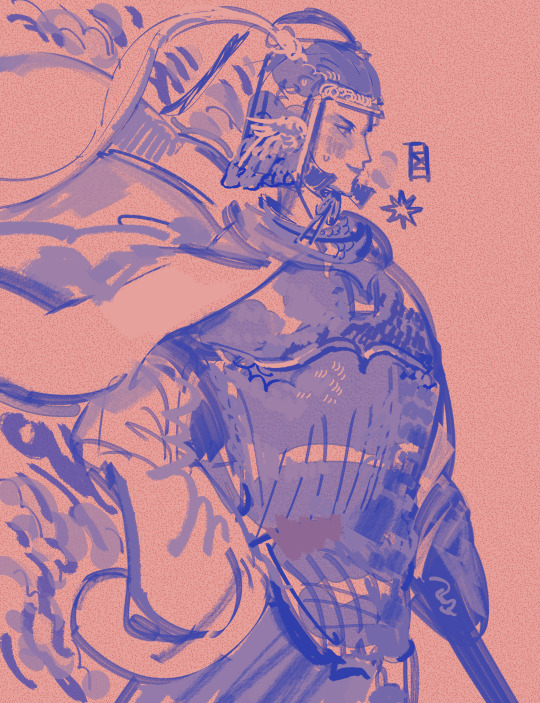
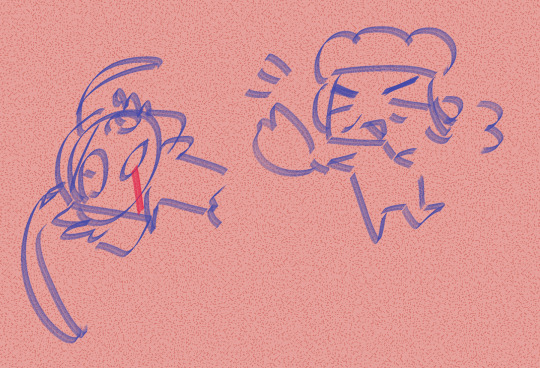
that one twink from three kingdoms
#romance of the three kingdoms#zhou yu#ancient china#hanfu#digital art#yix gallery#rotk#three kingdoms#doodle#designs referenced from the rotk comic
185 notes
·
View notes
Text
An informative post on the history of hanfu and current development of the hanfu revival movement.
203 notes
·
View notes
Text
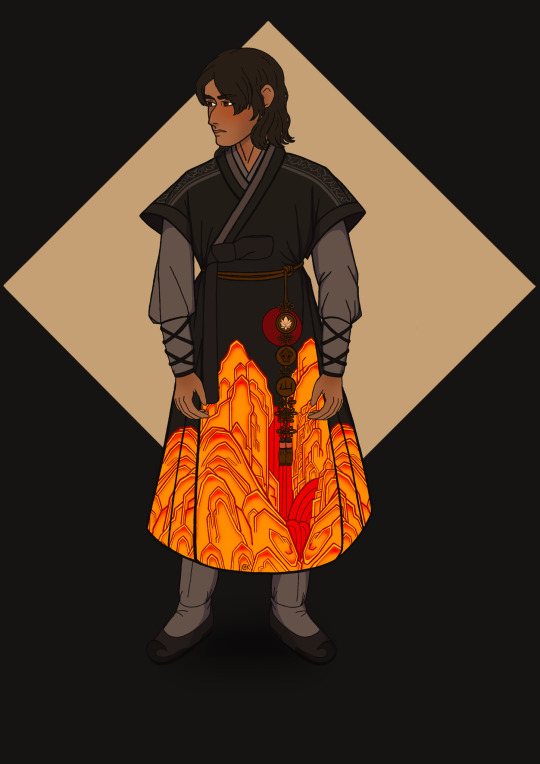

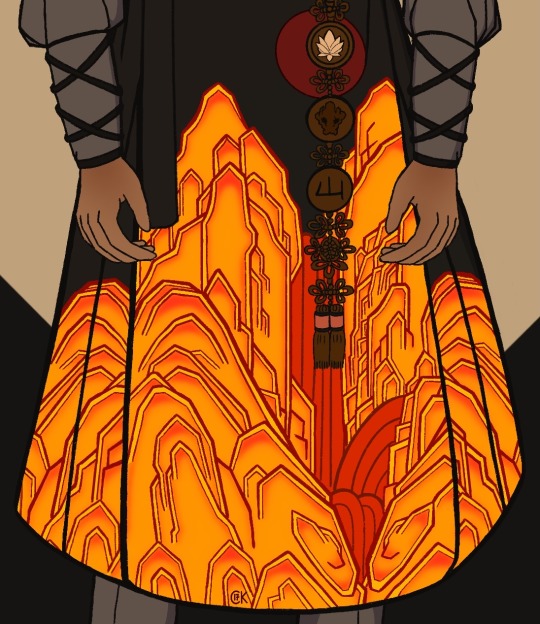
Here’s Cole in a hanbok!! Ninjago takes inspiration from many places, but it probably takes the most inspiration from East Asia, particularly Japanese and Chinese cultures. I’ve seen many drawings of the Ninja in kimonos and occasionally hanfu, so I wanted to draw Cole in a hanbok, or Korean traditional clothing. Korea is another East Asian country between Japan and China, so I thought it would be cool for him to wear another kind of traditional clothing.
#ninjago#ninjago fanart#lego ninjago#cole ninjago#ninjago cole#the mountains are based off of minhwa a Korean folk art style#hanbok#I’m Korean but designing a hanbok took way more research than expected#there are 6 mountains on his hanbok guess why#the red part isn’t waterfalls it’s supposed to be lava#this will probably be a series… hopefully#ninjago cole fanart#Ninjago hanbok#CK17art#Ninjago hanbok series
1K notes
·
View notes
Note
I don't mean this to come off as conceited, I'm genuinely curious. In the case of the most recent 'Tang Dynasty style' video, and the 'Hanfu hair and make-up' one as another example.
I don't mean to ask you to speak for the content creators, or all Chinese, but might the choice to feature not conventionally attractive "model-type" models in those videos have been informed by the kind of body positivity that western culture had become a battleground for? Or would that be projecting a form of identity politics that doesn't translate as simply as that?
Are those kinds of issues/discussions something that chinese society makes time for, or are they not made so much of an issue of as in countries such as the USA for example.
Sorry again if the question is asked clumsily.
Videos referenced: 1, 2
I don't really know that much (deeply) about the body positivity movement in either the U.S or how it may or may not influence any similar movement in China, so I can't opine as to what that has to do with the videos.
I will say that beauty ideals in the Tang dynasty favored fuller faces and bodies, reflecting a sense of richness in health and... well, wealth. You can see this in depictions from art:
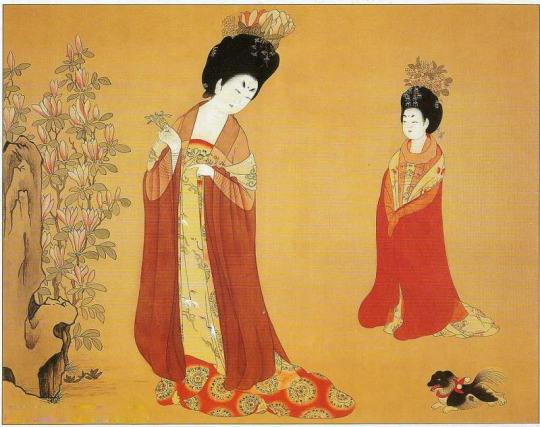
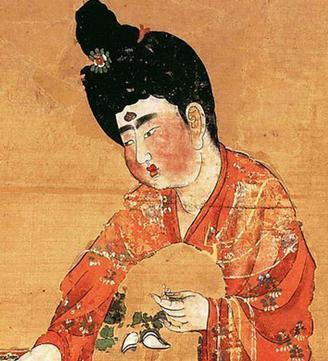
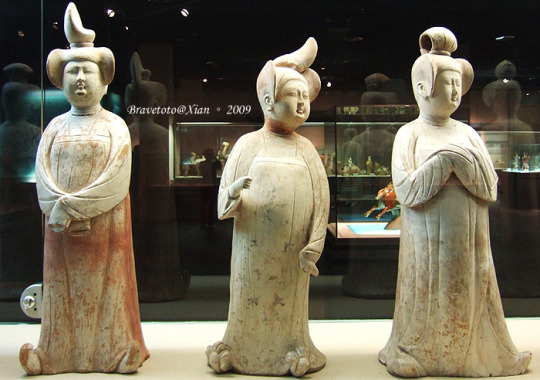
From my perspective, this has translated into modern day where people continue to think that fatter girls wearing Tang dynasty styles just looks right/feels right. Though fat girls undoubtedly get criticised unfairly a lot for their size in the regular day (bodyshaming in Asian cultures is pretty rampant and normalised), when they wear Tang dynasty hanfu, typically they get complimented a lot (although yes, that includes backhanded compliments) and compared to art.
So I guess what I'm saying is fat girls may be drawn to wearing Tang dynasty hanfu because it's generally thought that the styles complement their figures, and audiences are more receptive/appreciative to fatness in this niche because it aligns with preconceived understandings/imaginations of Tang dynasty styles.
A second perspective is, hanfu enthusiasts like to say that hanfu/traditional clothing can make any "plain jane" look beautiful. It is a point of pride that everyone looks good in hanfu and a good way to get more people to wear or try hanfu (if that is goal of the hanfu revival movement) is to show that it can look good no matter the starting point.
And I think regarding the idea of the content creators' "choice to feature...", this is more so the reason behind it in most cases. For the hanfu looks video, if the makeup artist/hair stylist can demonstrate the success of their work across a diverse range of skin types, face shapes, etc, they can acquire more business from the average person searching to hire someone's services.
--
TLDR: With regards to Tang dynasty hanfu and plus size models/wearers, I think it has little to do with body positivity and more to do with it fitting a cultural/historical standard.
294 notes
·
View notes